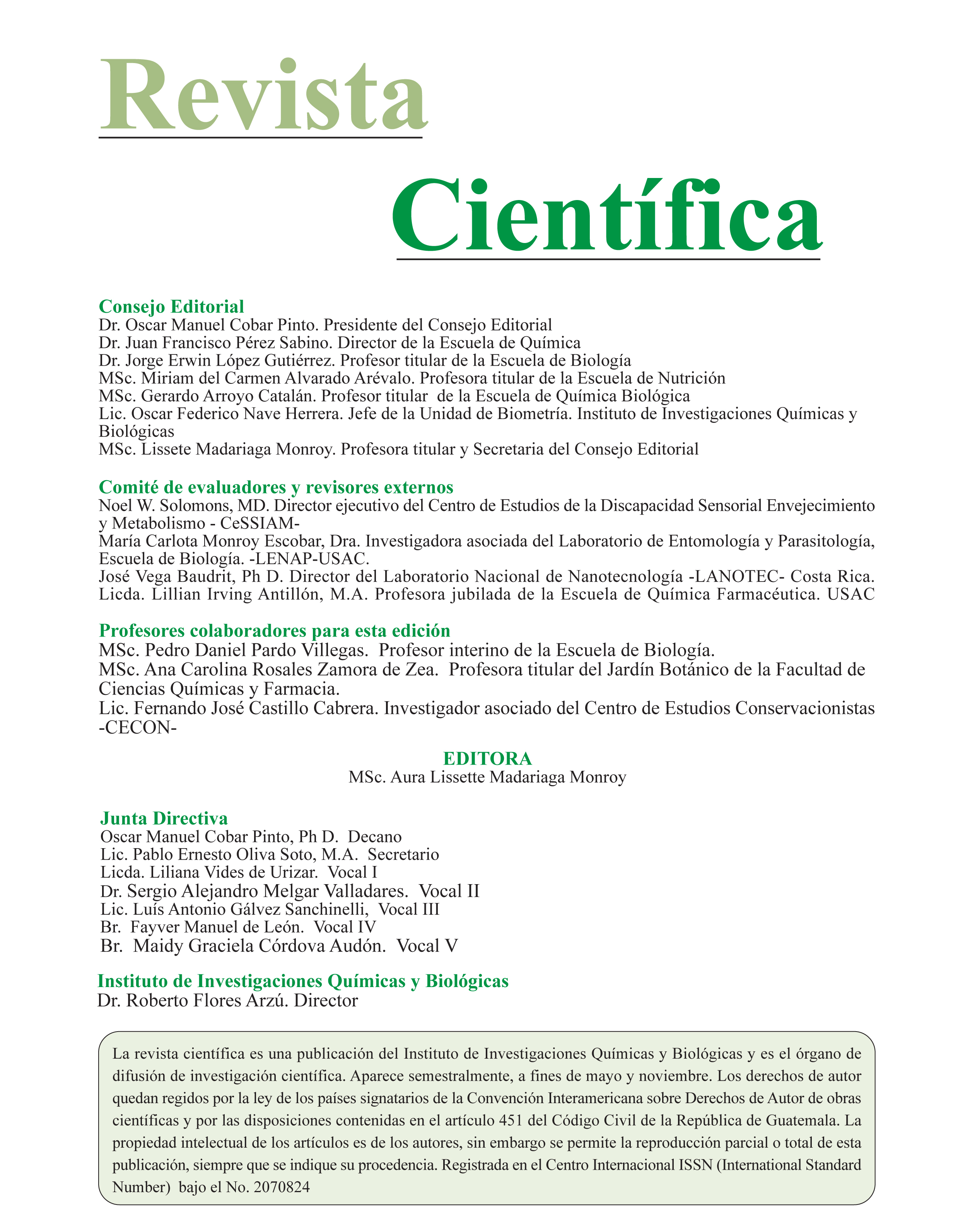Characterization of the by-product rice husks in search of possible applications as raw material in processes
DOI:
https://doi.org/10.54495/Rev.Cientifica.v23i1.115Keywords:
characterization, lignocellulosic, husk, rice, by-productAbstract
The treatment of the solid waste responsible of environmental pollution is one of the most important concerns at the present time; as appropriated methods for the handling and discarding are seek. Lignocellulosic materials incorporation in the manufacture process is an increasing trend due to the production of environmentally friendly products which are similar to those made with commercially available raw materials. Rice hulls are a byproduct of the rice milling process. Rice hulls were characterized according to the ASTM procedures. Relevant characterization results are the alpha cellulose (19.736%) and lignin (6.270%) content of the rice hulls.
Downloads
References
Alma, M. H., Altay M., Digrak M. (2003) New polyurethane-type rigid foams from liquified woods powders. Journal of materials science letters 22. 1225 – 1227. https://doi.org/10.1023/A:1025356702660 DOI: https://doi.org/10.1023/A:1025356702660
Angladette, A. (1969) El Arroz, Editorial Blume, Barcelona, España.
American Society for Testing and Materials. (2008) Standard Test Method for Apparent Density of Rigid Cellular Plastics (D1622)
American Society for Testing and Materials. (2007) Standard Test Method for Acid-Insoluble Lignin in Wood (D1106-96)
American Society for Testing and Materials. (1968) Standard Test Method for Alpha-Cellulose in Wood (D1103-60)
American Society for Testing and Materials. (2007) Standard Test Method for Ash in Wood(D1102-84)
American Society for Testing and Materials. (2004) Standard Test Method for Compressive Properties of Rigid Cellular Plastics (D1621-04a)
American Society for Testing and Materials. (2007) Standard Test Method for Ethanol-Toluene Solubility of Wood (D1107-96)
American Society for Testing and Materials. (1972) Standard Test Method for Holocellulose in Wood (D1104-56)
American Society for Testing and Materials. (1972) Standard Test Method for Preparation of Extractive-Free Wood (D1105-56)
American Society for Testing and Materials. (2005) Standard Test Method for Testing Polyurethane Raw Materials : Determination of Hydroxyl Numbers of Polyols (D4274-05)
American Society for Testing and Materials. (2007) Standard Test Method for Water Solubility of Wood (D1110-84)
Barba, C. (2002) Síntesis de carboximetilcelulosa (CMC) a partir de plantas anuales, Memoria para optar por al grado de Doctor en Ingeniería Química, Departament d’Enginyeria Química, Escola Tècnica Superior d’Enginyeria Química Universitat Rovira I Virgili, Tarragona, España.
Basta, A., Abd El-Sayed E., El-Saied H. (2004) Lignocellulosic materials in building elements. Part IV – Economical manufacture and improvement of propierties of light – weight agro – panels. International Journal of Polymeric Materials. 709 – 723. https://doi.org/10.1080/00914030490472917 DOI: https://doi.org/10.1080/00914030490472917
Bienvenido, J. (1985) Rice: Chemistry and Technology. The American Association of Cereal Chemist, Minnesota, USA.
Chahar, S., Dastidar, M. G., Choudhary, V., Sharma D. K. (2004). Synthesis and characterisation of polyurethanes derived from waste black liquor lignin. J Adhesion Sci. Technol., Vol 18, Nº 2, pp. 169 – 179. https://doi.org/10.1163/156856104772759386 DOI: https://doi.org/10.1163/156856104772759386
Corporación Arrocera Nacional. (CONARROZ, 2008) Informe estadístico período 2006/2007, Costa Rica.
Corporación Arrocera Nacional. (CONARROZ, 2009) Informe estadístico período 2007/2008, Costa Rica.
Delgado, K. (2004) Uso alternativo de residuos de caña de azúcar para la obtención de espumas rígidas de poliuretano, (Tesis Licenciatura en Química Industrial, Escuela de Química, Universidad Nacional, Heredia, Costa Rica).
Echandi, O. (1975) Alimentación del ganado con raciones a base de cascarilla de arroz, bagazo de caña o pulpa de café comparadas con pastoreo libre en verano. (Tesis Ingeniero Agrónomo, Escuela de Zootecnia, Universidad de Costa Rica, San José, Costa Rica).
Fishman, M., Friedman, R., Huang, S. (1994) Polymers from Agricultural Coproducts, American Chemical Society, Washington, USA. https://doi.org/10.1021/bk-1994-0575 DOI: https://doi.org/10.1021/bk-1994-0575
Kozlowski, R., Wladyka – Przybylak, M., Helwig M. (2004) Composites based on lignocellulosic raw materials. Mol. Cryst Liq. Cryst. Vol 418, pp. 131 – 149. https://doi.org/10.1080/15421400490479217 DOI: https://doi.org/10.1080/15421400490479217
Ni, P., Thring, R. (2003) Synthesis of Polyurethanes from solvolysis lignin using a polymerization catalyst: mechanical and thermal properties. International Journal of Polymeric Materials, 52: 685–707. https://doi.org/10.1080/00914030304931 DOI: https://doi.org/10.1080/00914030304931
Oertel, G. (1985) Polyurethane Handbook, Mc Millian Publishing, Co, New York, USA.
Saunders, J. H. (1961) Polyurethanes chemistry and technology, Interscience Publishers, New York, USA.
Sun, L., Gong, K. (2001) Silicon-Based Materials from Rice Husks and Their Applications. Ind. Eng. Chem. Res. 40, 5861 – 5877. https://doi.org/10.1021/ie010284b DOI: https://doi.org/10.1021/ie010284b
Valero, M., Pulido, J., Ramírez, A., Cheng, Z. (2008) Estudio de las propiedades mecánicas, térmicas, reológicas y morfología de poliuretanos a partir de aceite de higuerilla modificado por transesterificación . Revista Iberoamericana de Polímeros. Vol 9 (2) pp 102– 118.
Vargas, E. (1995) El valor nutritivo de los subproductos del arroz en Costa Rica. Composición química, disponibilidad y uso. Nutrición animal tropical. Vol 2 Nº1 pp 31– 50
Vásquez, D. (1986) Estudio del Complejo Lignina-Fenol-Formaldehido y su posible utilización como plastificante. (Tesis de Ingeniería Química, Escuela de Ingeniería Química, Universidad de Costa Rica, San José, Costa Rica).
Vega, J. (1994) Obtención de espumas rígidas de poliuretano a partir de cáscaras de piña. (Tesis de licenciatura en Química, Escuela de Química, Universidad de Costa Rica, San José. Costa Rica).
Downloads
Published
How to Cite
Issue
Section
License
Copyright (c) 2013 J. Vargas, P. Alvarado, J. Vega-Baudrit, M. Porras

This work is licensed under a Creative Commons Attribution 4.0 International License.
Authors who publish with this journal agree to the following terms:
- Authors retain copyright and grant the journal right of first publication with the work simultaneously licensed under a Creative Commons Attribution License 4.0 that allows others to share the work with an acknowledgement of the work's authorship and initial publication in this journal.
- Authors are able to enter into separate, additional contractual arrangements for the non-exclusive distribution of the journal's published version of the work (e.g., post it to an institutional repository or publish it in a book), with an acknowledgement of its initial publication in this journal.
- Authors are permitted and encouraged to post their work online (e.g., in institutional repositories or on their website) prior to and during the submission process, as it can lead to productive exchanges, as well as earlier and greater citation of published work.









